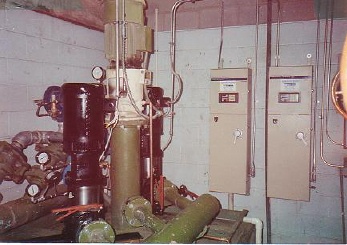226
Pumps, Wells, Tanks, Controls / VFD Soft Starter not soft enough
« on: March 13, 2007, 08:06:50 PM »
I spent the day at a rural water system in north Texas. They are trying to use a couple of VFD’s as soft starters for two 40 HP Berkeley centrifugal pumps. 5,000 feet from the pump station to a stand pipe, through a 6" main, with distribution all along the way. Pump has got to build 48 PSI before it starts moving water against the static head of the stand pipe. 3500 RPM pump doesn’t build 48 PSI until it reaches 2700 RPM.
Programmed to take 30 seconds to start up, the VFD spins the motor for 25 seconds before it reaches 2700 RPM. Then the last 5 seconds gets it to 3500 RPM and the pressure gauge pegs out over 100 PSI, and slowly comes back to about 78 PSI fairly steady.
We changed it to take 2 minutes to reach full speed. The pump rattles through about 3 critical speeds during the minute and 40 seconds it takes to reach 2700 RPM. The last 20 seconds is really all the soft start there is during 2 minutes of ramp up. 20 seconds is really not enough to stop a pressure spike. The pressure quickly went to about 90 PSI before settling back to 78 PSI.
Then we tried ramping it down slowly. Told to take 60 seconds to ramp down, nothing happened for about 10 seconds. Then the pressure dropped off so fast, there wasn’t much difference from just cutting off the power. The system dropped from 78 PSI to 10 PSI, bounced back to 80 and then hit 0 or lower. The gauge bounced back and forth, subsiding a little each time for about 2 minutes, until it steadied out at 48 PSI, which is tower pressure.
The VFD or soft starter causes the pump to vibrate considerably, spending too much time going through several critical speeds. The whining noise as the pump ramped up, was so loud that it drove the water operator out of the building each time. The pressure bounces around so much, that pressure control to start and stop the pumps and alternate between the two would not work so, we were operating the pumps on manual. Now they have to buy a telemetry system to operate the pumps from the stand pipe 5,000 feet away.
At least the motor had a sticker on it claiming “Inverter Duty Voltage Spike Resistant Windings”. This will help with the 2,000+ volt spikes sent to it by the Drive. There was no load or line reactor type filter so, the odd numbered harmonics are being fed back into the power grid as well. No grounding brushes on the rotor so, I am sure the ball bearings will be damaged by electrical fluting from the EDM currents very soon.
They are adding another stand pipe to the system and drilling another well. The control system is going to get crazy. This is not over. I will let you know what they do. I got some great footage. Will be making a short video with it soon.
Cary
Programmed to take 30 seconds to start up, the VFD spins the motor for 25 seconds before it reaches 2700 RPM. Then the last 5 seconds gets it to 3500 RPM and the pressure gauge pegs out over 100 PSI, and slowly comes back to about 78 PSI fairly steady.
We changed it to take 2 minutes to reach full speed. The pump rattles through about 3 critical speeds during the minute and 40 seconds it takes to reach 2700 RPM. The last 20 seconds is really all the soft start there is during 2 minutes of ramp up. 20 seconds is really not enough to stop a pressure spike. The pressure quickly went to about 90 PSI before settling back to 78 PSI.
Then we tried ramping it down slowly. Told to take 60 seconds to ramp down, nothing happened for about 10 seconds. Then the pressure dropped off so fast, there wasn’t much difference from just cutting off the power. The system dropped from 78 PSI to 10 PSI, bounced back to 80 and then hit 0 or lower. The gauge bounced back and forth, subsiding a little each time for about 2 minutes, until it steadied out at 48 PSI, which is tower pressure.
The VFD or soft starter causes the pump to vibrate considerably, spending too much time going through several critical speeds. The whining noise as the pump ramped up, was so loud that it drove the water operator out of the building each time. The pressure bounces around so much, that pressure control to start and stop the pumps and alternate between the two would not work so, we were operating the pumps on manual. Now they have to buy a telemetry system to operate the pumps from the stand pipe 5,000 feet away.
At least the motor had a sticker on it claiming “Inverter Duty Voltage Spike Resistant Windings”. This will help with the 2,000+ volt spikes sent to it by the Drive. There was no load or line reactor type filter so, the odd numbered harmonics are being fed back into the power grid as well. No grounding brushes on the rotor so, I am sure the ball bearings will be damaged by electrical fluting from the EDM currents very soon.
They are adding another stand pipe to the system and drilling another well. The control system is going to get crazy. This is not over. I will let you know what they do. I got some great footage. Will be making a short video with it soon.
Cary


